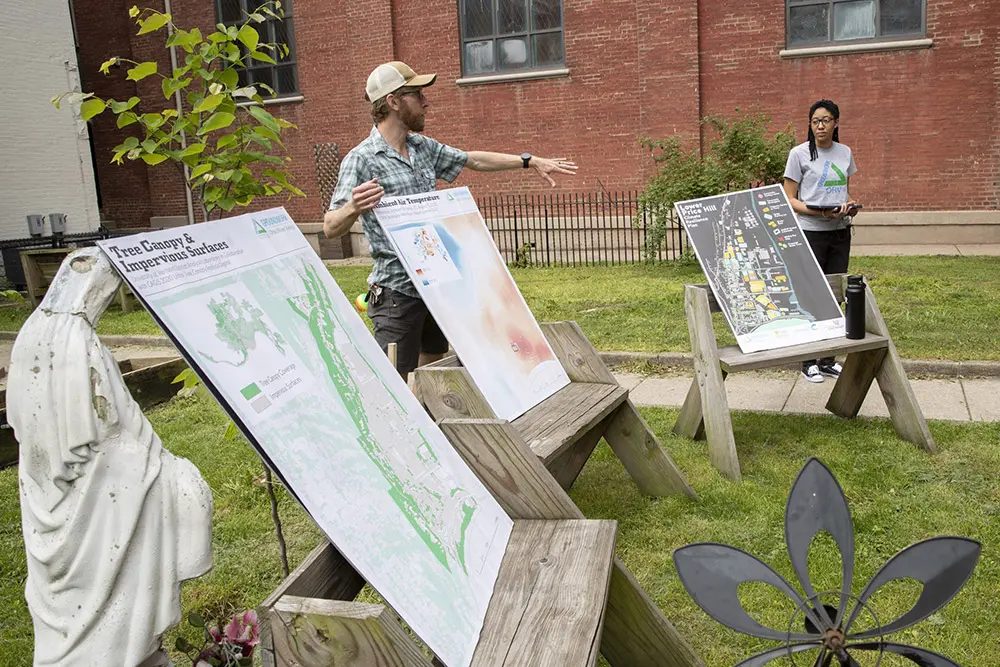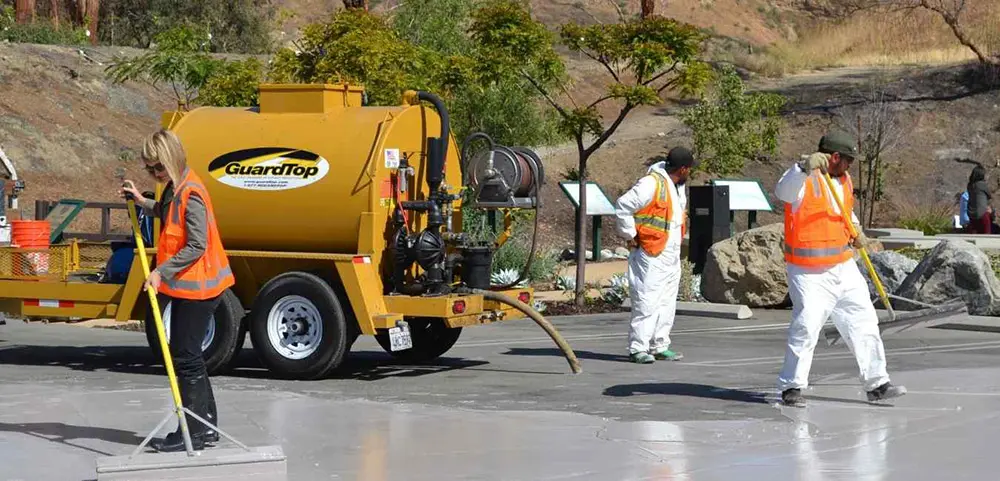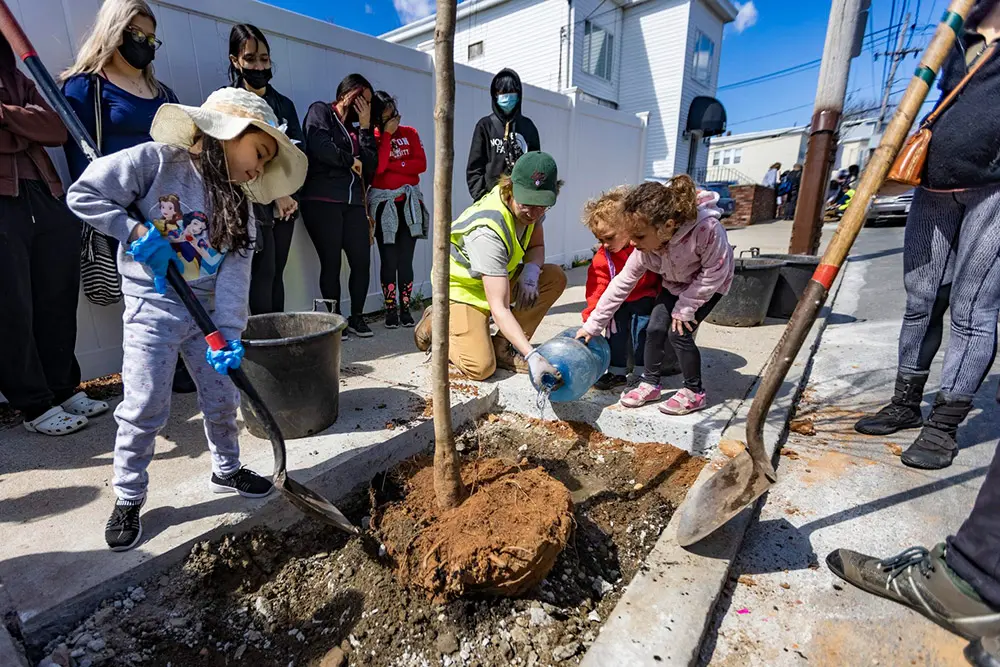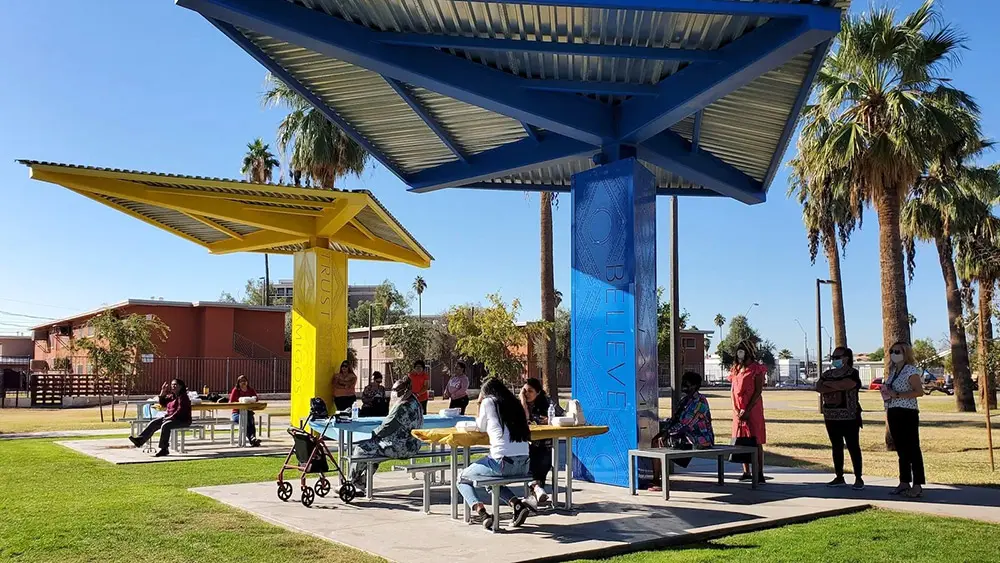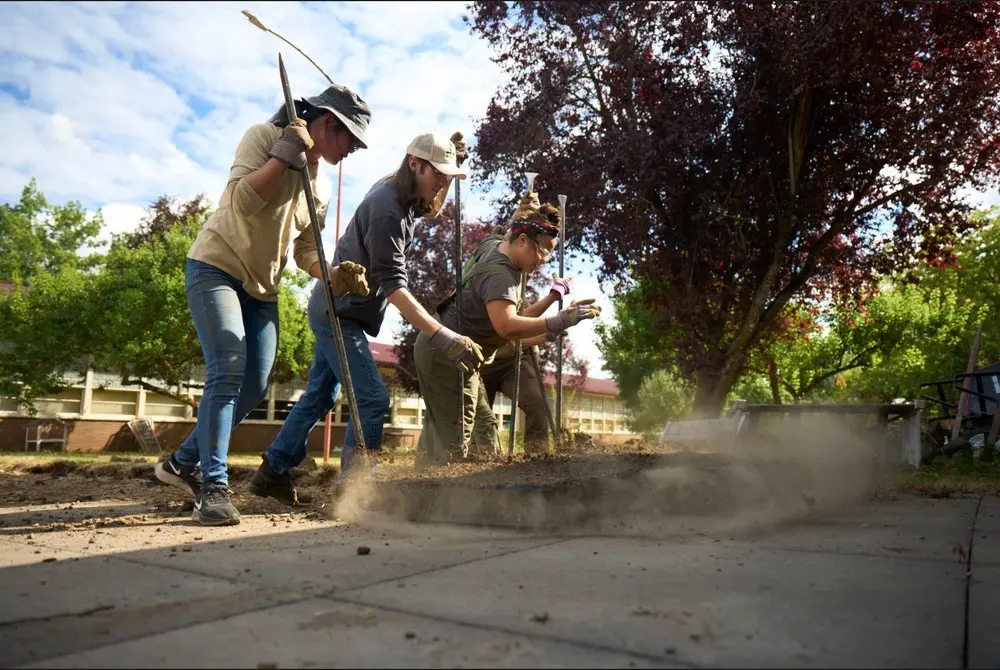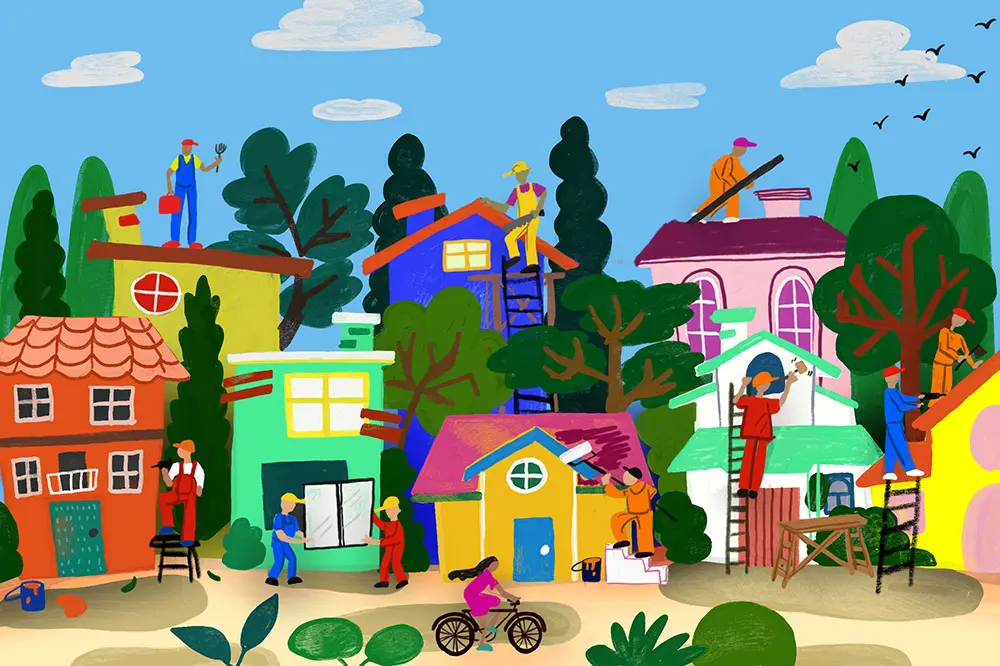Climate resilience as Urban Cooling
Urban Cooling is a powerful tool to:
- Buffer communities from the urban heat island effect and the dangers of extreme heat events
- Improve air quality
- Reduce energy use and greenhouse gas emissions
- Preserve biodiversity by creating habitat
- Reduce stormwater runoff and flooding
- Boost mental health and social cohesion
- Create good jobs

What it is: A toolkit of design, planning, and community care strategies designed to ameliorate the effects of the urban heat island effect and keep city residents cool and safe through extreme heat events. Urban cooling strategies can include:
- Safe, appealing alternatives to car transit, like walking, biking, and public transportation, which can help take heat-producing cars off the street and shrink the size of heat-absorbing asphalt roads and parking lots. (Plus: Anytime fossil fuel-powered cars are taken off the road, that’s a win for climate change mitigation and local air quality!)
- Light-colored and reflective coatings applied to roads, roofs, and building facades, which have been effective in reflecting rather than absorbing heat. White roofs can reduce the temperature inside the building by an average of 4-5°F, and black asphalt roads assessed in Los Angeles were shown to be a whopping 23°F cooler after they were coated with a white, highly reflective sealant! (Plus: Cool roofs can reduce energy expenses for building residents. According to NYC CoolRoofs, roofs painted with a light-colored, reflective coating reduce air conditioning costs by 10-30% on hot summer days.)
- Removing pavement altogether. When dark, heat-absorbing, and impervious asphalt is replaced with permeable pavement, vegetation, and other natural ground cover options, water is able to infiltrate and then evaporate when it gets hot, naturally cooling the atmosphere. Preliminary studies suggest that removing just 10% of a neighborhood’s pavement could lower temperatures by 7°F! De-paving walking and biking paths, playgrounds, parking lots, and vacant lots is an excellent place to start. (Plus: When impermeable pavement is removed and water is able to infiltrate into the ground, groundwater aquifers are replenished and stormwater runoff is reduced. De-pavement efforts can help to regulate the water cycle and buffer the impacts of periods of drought and heavy rains.)
- Simple shade structures and water features, like fountains, sprinklers, public swimming pools, water spray parks, and misting systems, which can give folks a cool respite at bus stops, on benches, and in public gathering spaces. Water features like sprinklers and misting systems can cool people off instantly as water evaporates from the skin, while bodies of water, like fountains, can lower the local temperature by stimulating the evaporation of water into the atmosphere.
- Weatherizing buildings by sealing gaps around doors and windows, installing attic and wall insulation, adding simple shading systems or solar window film to block out the sun, replacing appliances, lighting, and temperature control systems with energy-efficient options, etc. Weatherization can help to keep hot air out, minimize solar radiation and internal heat sources, and lower humidity levels, significantly improving thermal comfort for residents. (Plus: Meeting the need for weatherization could create tens of thousands of good jobs and opportunities for workforce development. In 2020 alone, the Weatherization Assistance Program supported 28,000 jobs, and there are still millions of buildings that could benefit from weatherization.)
- Cooling centers, or public spaces with air conditioning that can provide lifesaving relief for folks who don’t otherwise have air conditioning at home or are experiencing a power outage. Good cooling centers are located in places where people naturally gather, like libraries, and have furniture for people to sit on and recline, activities and facilities for children, toiletries for unhoused folks, cool drinks and snacks, power outlets for folks to charge their devices or use their electricity-dependent medical equipment, etc. Cooling centers should be equipped appropriately so that people, and particularly elders, disabled folks, unhoused folks, and young children, who are generally most vulnerable to extreme heat, can comfortably spend the whole day there. (Plus: Well-equipped cooling centers can serve as community resilience hubs during a wide range of climate-related and non-climate-related disasters alike.)
- Community care strategies, like neighborhood extreme heat plans, first aid trainings, or basic practices like checking in on neighbors or distributing frozen water bottles to unhoused folks. Community care is an absolutely essential element of keeping folks safe during extreme heat events. When public sociologist Eric Klinenberg was analyzing Chicago’s 1995 extreme heat event, during which over 700 people died, he found that community cohesion, or lack thereof, was the largest predictor of how neighborhoods fared during the heatwave. People were far more likely to survive if they had a close connection to another person.
- Adding plants in all forms, including green walls and roofs, parks, community gardens, green corridors, urban forests, and even potted indoor plants. Plants cool the air temperature by stimulating transpiration, the process by which water vapor is released from plant leaves into the atmosphere. Trees, which also deflect solar radiation and provide shade, are generally the most efficient heat mitigation strategy, particularly when clustered in places where people gather or that they utilize frequently, like in parks, along highly trafficked walking paths and sidewalks, and by buildings. A 2023 study published in peer-reviewed public health journal The Lancet found that doubling the average amount of tree cover in European cities from 15% to 30% could reduce heat-related deaths by more than a third! Other forms of vegetation can have a dramatic impact on lowering temperatures, too; one climate researcher found that walls covered in vining plants had surface temperatures 40°F lower than their bare-walled counterparts next door on extremely hot days, and the temperature on Chicago City Hall’s green roof is approximately 80°F cooler than nearby conventional roofs on a typical day. (Plus: Plants support biodiversity by providing habitat and filtering the air, water, and soil. The presence of plants can meaningfully reduce acute and chronic stress and offer other mental health benefits for folks who live, work, and play in the neighborhood. Green spaces can bolster social cohesion and neighborhood pride. There is even a direct correlation between green surroundings and lower crime rates when controlling for other variables. The list goes on!)
I always tell people, if you have a problem, trees can help. Ked Stanfield, Executive Director of Louisville Grows (source)
Some additional context: As heat waves become longer, hotter, and more frequent, urban communities experience the impacts most intensely; cities can be up to 22°F hotter than surrounding rural and suburban communities, and they are heating up at twice the rate of non-urban areas. The urban heat island effect results from large swaths of concrete and asphalt, which absorb and radiate the sun’s rays, as well as urban canyons formed between tall buildings that trap heat at the street level. Because heat can’t dissipate well, the urban heat island effect is felt most acutely at night, as temperatures remain high and residents don’t experience a reprieve for their bodies to cool down. The effect is exacerbated by high concentrations of gas-powered vehicles, air conditioning units, and other sources of heat. a
Not every urban neighborhood is affected equally, though. There is tremendous temperature variation within cities, and even within neighborhoods, typically mapping with the racial and socioeconomic history of the region. On average, communities that have been structurally marginalized have significantly fewer trees and green spaces and more parking lots and pavement. In fact, a 2020 study of 108 urban areas across the United States found that formerly redlined neighborhoods of nearly every city studied were notably hotter than nonredlined neighborhoods, sometimes by nearly 20°F. Low-income communities and communities of color are therefore disproportionately impacted by the urban heat island effect. Unfortunately, the disparity in the experience of extreme heat along race and class lines is often exacerbated by lack of access to air conditioning.
The consequences of extreme heat are serious. When people consistently experience high temperatures without relief, they’re vulnerable to dehydration, heat exhaustion, heatstroke, mental stress, diminished cognitive function, and even death. In the so-called United States, heat waves are responsible for more deaths than any other natural disaster; as many as 12,000 people die from extreme heat each year. Again, not all bodies are affected by extreme heat equally; children, elders, pregnant people, unhoused folks, folks who do physical labor outside, and disabled folks are most vulnerable to the dangers associated with extreme heat. Extreme heat can also exacerbate ozone pollution levels, which can trigger asthma attacks and cardiovascular issues, and sometimes leads to power outages, which can endanger folks who rely on electricity-dependent medical equipment.
As the climate crisis intensifies, heat waves are bound to become longer, hotter, and more frequent, particularly in cities, where an estimated 83% of the American population resides. Urban cooling projects can and should work on different levels to (1) counter the urban heat island effect, so that cities don’t heat up as much; (2) counter the legacy of racist planning and policy, so that temperature disparities between neighborhoods no longer exist; (3) ensure that urban residents have access to relief even on days when their neighborhood is hot, so that they’re able to cool down and avoid health emergencies; (4) ensure that community members are equipped with training so that they can care for one another when someone is experiencing a heat-related health issue; (5) protect workers from laboring in unsafe conditions, and more. Urban cooling projects are meant to improve comfort and quality of life during extreme heat events as well as prevent acute health emergencies and avoidable deaths, particularly for those most exposed to and/or vulnerable to extreme heat.
Continue readingThere's no panacea, there's no 100% solution to the climate crisis or to the racial and economic injustice that puts some people at greater risk than others. Instead what we do have control over and what we can implement are enough small, 1% hyper-local solutions to tip the scales towards equity. Cate Mingoya-LaFortune, National Director of Climate Resilience and Land Use for Groundwork USA
The nuance / caveats:
There are numerous caveats to keep in mind when employing urban cooling strategies:
- Particularly when addressing urban heat disparities that are the product of decades of racist policy and planning, it’s not enough to simply coat the road with cooling sealant or plant a few trees on the block. It’s also critical to shift the systems that left neighborhoods overpaved and underresourced to begin with. As Cate Mingoya-LaFortune says, “Our neighborhoods don’t look the way that they do by accident. So when we think about making changes to the built environment to help reduce the impact of heat, we have to ask the question, why has change not yet come about?” Ultimately, efforts to address urban heat must be coupled with efforts to advance housing justice, energy justice, racial justice, disability justice, workers rights, and other liberatory movements.
- Urban cooling projects should always be community-led. First and foremost, local residents deserve the autonomy to decide what their neighborhood looks and feels like. Second of all, community-led projects are more effective, since the people who live, work, and play in the neighborhood will always be the foremost experts on where it’s hottest and which solutions will make sense for the community. And when people have ownership over a project, it’s more likely to be maintained for the long haul, too (and many urban cooling strategies, like urban forestry, rely on long-term community engagement). Thirdly, many types of urban cooling projects, like planting trees, transforming vacant lots, building new parks, pathways, and gathering spaces, renovating buildings, etc., can trigger displacement (the phenomenon of “green gentrification” is very real). It’s crucial that a neighborhood’s long-term residents are in control and can reap the rewards of urban cooling projects without fear of being pushed out.
- No single urban cooling strategy is a panacea, so it’s important to explore a variety of strategies that mitigate different impacts of extreme heat. At the same time, not every strategy is compatible. For instance, light-reflective pavements and shady trees do not pair well! Again, it’s important that urban cooling tactics are utilized with tremendous thoughtfulness and community engagement, otherwise they won’t be particularly impactful, and they may even do more harm than good.
- Along those lines, applying light, reflective coatings to pavement is tricky business. They are a relatively new innovation and people are still figuring out how to use them effectively. A recent study found that cooling sealants lowered the surface temperature of the ground but increased the air temperature above the ground. Since the sealant reflects rather than absorbs the sun’s rays, it can actually make heat more unbearable for pedestrians and cyclists. Therefore, in most cases, reflective coatings probably shouldn’t be applied to sidewalks, biking paths, playgrounds, or narrow roads flanked by buildings.
- Equitable access to air conditioning is crucial to public health and safety. In cities that regularly experience extreme heat, consistent and affordable access to air conditioning is arguably a human right. And, air conditioners pump waste heat into the air, are often energy-intensive, and can leak heat-trapping refrigerants into the air, exacerbating the urban heat island effect directly and indirectly. And, as more and more people use AC to deal with heat, the increased demand for energy can overload electric lines, transformers, and other equipment, triggering power outages. Making air conditioners more efficient, affordable, and accessible is critical, as is finding ways to reduce need for air conditioning in the first place.
- Due to the nature of the problem, holistic urban heat strategies usually require collaboration. Many urban heat projects involve partnerships between community-based organizations and organizers, local and/or regional government, researchers, and neighborhood residents.
Spotlights

Groundwork USA is a national support organization for a network of 22 local Trusts dedicated to transforming the natural and built environment of underresourced communities and advancing resident-led initiatives for community health, equity, and resilience. Their Climate Safe Neighborhoods partnership, a 16-city program focused specifically on communities with histories of race-based housing discrimination, is doing a phenomenal job of mitigating the urban heat island effect while addressing the roots of urban heat disparities. The program unfolds in three stages; first, community members come together over maps, oral histories, and community science (such as collecting ambient air temperature data) to better understand why their community looks the way that it does. Next, neighborhood residents prioritize the types of changes to the built environment that they would most like to see to protect themselves from climate hazards. Finally, Groundwork team members and residents work together to build their capacity to intervene in local systems to create meaningful change, and Groundwork Trusts act as trusted intermediaries between the local government and residents. The program has thus far resulted in several successful, resident-led initiatives; in Richmond, Virginia, residents helped to modify the city’s 10-year master plan to prioritize neighborhoods with a high heat vulnerability index, and Groundwork Rhode Island’s participants influenced the state government to move to a tree distribution model that uses the tree equity score to place trees where they’re needed most.
To support Groundwork USA, consider making a donation, getting involved in a local Trust, or even starting a new Groundwork Trust in your community!
Continue reading about Urban Cooling
Climate Resolve is a Los Angeles-based climate justice organization focused on connecting communities, grassroots groups, and policymakers to advance practical, resident-led initiatives that mitigate greenhouse gas emissions and prepare neighborhoods for climate impacts. In neighborhoods most impacted by the urban heat island effect, like Canoga Park, they’re working closely with community members to develop and implement comprehensive design and planning strategies, like maximizing greenery, incorporating cool paving, dedicating more space to pedistrians and bikers, minimizing traffic congestion, and more. Climate Resolve has also helped to shape and win major local and state policy victories for urban cooling, such as California’s Extreme Heat Action Plan, which includes an $800 million package to address extreme heat by expanding tree canopies, implementing cool streets and roofs, creating resilience hubs, strengthening communication systems, and more. In all of their efforts, they’re focused on ensuring that climate mitigation and adaptation solutions are equitable and just, and that no communities get left behind. For instance, they recently published an in-depth report examining how climate change is impacting California’s essential workers and offering policy and practice recommendations to better protect workers from extreme heat and other climate hazards.
To support Climate Resolve, consider making a donation, engaging in one of their ongoing campaigns, or signing up for their newsletter to stay abreast of events and calls to action, especially if you’re an Angeleno.
Continue reading about Urban Cooling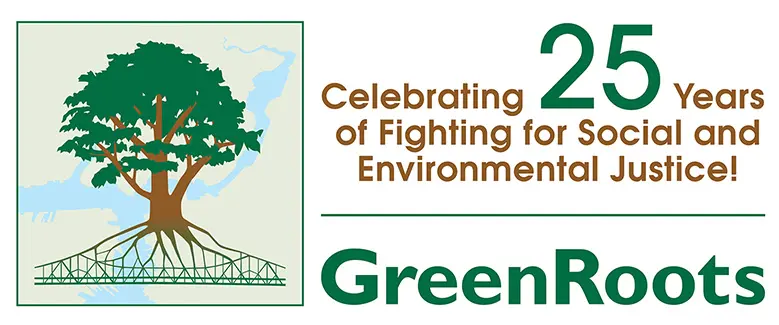
GreenRoots is a community-based environmental justice organization in Massachusetts’s smallest city. They’re currently piloting Chelsea’s Cool Block project on the hottest block in the city, according to preliminary research conducted in collaboration with the city and Boston University’s School of Public Health researchers. They are utilizing an entire toolkit of urban cooling strategies on this singular block to figure out what works best and how to replicate those approaches elsewhere in the city. So far, they’ve planted 47 trees, replaced the sidewalk with porous pavers, planters, and white concrete, swapped the dark asphalt road with lighter gray asphalt, hosted a design contest to transform and green a vacant lot, and are working on installing a white roof on the Boys and Girls Club. They’re also applying for grants so that they can pay residents to water the trees because they know long-term maintenance is key to urban forestry success!
To support GreenRoots, consider making a donation, signing up for their newsletter, or if you’re local to Chelsea, Massachusetts, becoming a member.
Continue reading about Urban Cooling
Louisville Grows is on a mission to foster green, just, and sustainable neighborhoods in Louisville, Kentucky, the fastest warming city in the country. The organization was founded by a group of guerilla gardeners who would gather to make seed bombs in their living rooms. Today, Louisville Grows has evolved to focus on advancing health equity through urban forestry and urban agriculture in neighborhoods that are most impacted by the urban heat island effect and food apartheid. Since the city’s tree canopy cover has been in decline for the past few decades (in 2004, the city’s tree canopy cover was about 40%, and today it’s estimated to be closer to 27% overall, with much lower canopy cover in formerly redlined neighborhoods), Louisville Grows has been particularly focused on preserving and expanding the city’s tree canopy. They work closely with neighborhood groups and community partners to plant trees with the consent and help of residents and they provide Citizen Forester training to interested community members in order to build capacity for long-term urban forest management and stewardship. Since about 70% of Louisville’s plantable spaces are privately owned, they do a tremendous amount of canvassing and outreach around residential tree planting, specifically; they go door to door asking folks if they want a tree planted in their yard (about 10% say yes), and then they help identify which tree(s) they’d like and coordinate the planting of the tree. They’ve recently expanded their tree planting efforts by partnering with The Nature Conservancy’s Green Heart Project, a program and study that will examine the link between neighborhood greenery and holistic human health.
To support Louisville Grows, consider making a donation, or, if you live in Louisville Kentucky, volunteering and/or signing up for their Citizen Forester training program.
Continue reading about Urban Cooling
Chispa Arizona is a grassroots group organizing Latine communities to grow political power and civic engagement for environmental and climate justice in Arizona. In partnership with the Nature Conservancy, Arizona State University, the Maricopa County Public Health Department, and other community-based organizations, they helped to develop hyper-local heat plans in three Phoenix neighborhoods most impacted by extreme heat. Phoenix is also one of the fastest warming cities in the country, and its low-income, predominantly Latine neighborhoods are an average of 3-5°F degrees warmer than the city’s wealthier, predominantly white neighborhoods. Chispa Arizona helped to mobilize local residents to share their ideas to invest in community spaces and build out shade and other amenities in parks and playgrounds, at bus stops, and along sidewalks. They also worked to strengthen communication systems and equip residents with first aid training to care for one another during extreme heat events.
To support Chispa Arizona, consider making a donation or, if you’re based in Arizona, become a member and/or plug into one of their many opportunities to take action, like attending one of their next Environmental Justice Escuelita webinars or joining a gardening session or community river clean-up.
Continue reading about Urban Cooling
Depave is a Portland, Oregon-based nonprofit committed to replacing unnecessary pavement with community green spaces. They work with public and private schools, local businesses, and houses of worship in overpaved areas to rip out heat-absorbing, impervious asphalt and, in its place, create community gardens, native plant learning gardens, bioswales, parks, etc. that will be an asset for the community. Community members, including children, are invited to come out and rip asphalt together- Depave team members find that the physical process is cathartic and allows community members to take the fate of their neighborhood into their own hands, literally.
To support Depave, consider making a donation or, if you live in Portland, Oregon, sign up to volunteer, submit a depaving project site, or sign up for their newsletter.
Continue reading about Urban CoolingResearch + reflection prompts:
- How has your community been impacted by extreme heat? How is it expected to be impacted by extreme heat in the years ahead?
- How might extreme heat be experienced differently across your community and how has that variation been shaped by historical policy and design choices?
- Which local organizations and organizers are working to ameliorate the urban heat island effect and related issues?
- Which public spaces could provide cool respite during a heat wave?
- Take a moment to dream: Where might you feel safest, coolest, and happiest on an extremely hot day? What does this place look, smell, taste, and feel like? How could you incorporate some of those elements into your home and community?
How to get engaged:
Citizen scientist
If you have access to time and a passion for data: Be a citizen scientist. Whether on your own or with community members, attach a thermal imager to your smartphone and begin collecting data. Start with your home; which areas stay coolest during hot days? Which areas trap the most heat, and how might you be able to help mitigate that? As you venture out and move around your neighborhood, make note of temperature extremes and any patterns that arise. Particularly if you’re able to gather a group of folks to acquire data in different areas of the neighborhood, this information could be invaluable in helping guide local government’s planning and heat wave response efforts. The same exercise can be conducted by getting in touch with your senses and making note of locations that feel the warmest and coolest, particularly on a hot, sunny day.
Lend your talents
If you have access to time and shareable skills: Lend your talents to organizations and organizers who are working to shift policy, planning, design, and emergency response to keep all community members safe amid extreme weather. Help amplify their work, fundraise, share your own expertise or resources, show up when volunteers are needed, recruit friends and neighbors to show up at town halls and community gatherings, and galvanize folks to submit public comments.
Community care
If you have flexibility during your day and/or access to transportation: Help care for the community members most vulnerable to heat wave impacts by coordinating rides to cooling shelters and shaded parks, making phone calls or in-person check-ins to neighbors, or distributing care packages filled with items like chilled water bottles, sports drinks, ice packs, snacks, towels, hats, or umbrellas to unhoused neighbors.
Gather neighbors
If you have access to a robust community network: Gather neighbors to form a heat emergency response plan. What are folks’ specific needs during an extreme event? Who will check in on who? What contact information would be helpful in an emergency? If you have the bandwidth, you may also choose to discuss cooling strategies that could be implemented on your block. Identifying favorite plants and agreeing upon a few places to add vegetation (such as the hell strip in between the sidewalk and street curb) are great places to start. Check out projects like Chelsea’s Cool Block for inspiration! Note that your city may have a specific permitting process or programs in place to support street cooling efforts, so volunteer or appoint a neighbor with the bandwidth to check local ordinances, liaise with the city, and coordinate logistics.
Organize coworkers
If your workplace is impacted by extreme temperatures: Organize coworkers to discuss and demand weather-related boundaries. If you are in a position of power at work, take the lead in listening to what your coworkers need and implementing inclusive policies designed to prioritize worker safety and health through extreme weather events.
Grow Indoor Plants
If you have a green thumb: Bring more plants into your home. Just as vegetation brings temperature relief to the outdoors, indoor plants cool the surrounding environment when they release excess water into the air from their leaves. Prioritize plants with lots of foliage, large leaves, and varieties that thrive in humid environments.
General best practices
Whether advocating for policy changes, supporting an organization’s ongoing efforts, or helping develop a cooling project in your neighborhood, make sure to center the folks who are most impacted by extreme heat and the urban heat island effect every step of the way.
A smattering of resources for continued learning + action:
Short Reads
- “What would a heat-proof city look like?” By Philip Oldfield in The Guardian
- “How to redesign cities to withstand heat waves” by Rebecca Leber in Vox
- ★ “How Decades of Racist Housing Policy Left Neighborhoods Sweltering” by Brad Plumer and Nadja Popovich in The New York Times
- “Can Planting Trees Make a City More Equitable?” By Patrick Sisson in Bloomberg City Lab
- “Urban trees can save lives” by Joseph Winters in Grist
- “Communities Step Up to Keep Neighbors Safe from Extreme Heat and Covid-19” by Maddie Kornfeld & Anna Belle in Yes Magazine
- “How Cities Can Combat the Dangerous Combination of Extreme Heat and Covid” by Eli Reiter in Yes Magazine
- “As a heat wave grips the US, lessons from the hottest city in America” by Julia Kane in Grist
- “Two leaders tell us how to beat the heat- on a systemic scale” by Fix staff in Grist
Reports & Guides
- Beating the Heat: A Sustainable Cooling Handbook for Cities by the Cool Coalition, UNEP, RMI, Global Covenant of Mayors for Climate & Energy, Mission Innovation, and Clean Cooling Collaborative
- Centering Equity to Address Extreme Heat: Preparing Communities for Hotter Days by the Urban Institute
- Urban Cooling Toolbox by C40 Cities
Long Reads
- ★ “Code Red: Baltimore’s Climate Divide” produced by Howard Center for Investigative Journalism, NPR and Capital News Service
- Heat Wave: A Social Autopsy of Disaster in Chicago by Eric Klinenberg
- After Cooling: On Freon, Global Warming, and the Terrible Cost of Comfort by Eric Dean Wilson
Watch
- How a hot city can keep its cool: a 3.5-minute video produced by Grist to introduce the urban heat island effect, why some neighborhoods are hotter than others, and urban cooling solutions
